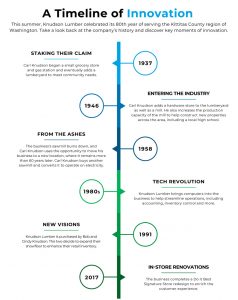In the early days of March, Cheryl Brown and the Knudson Lumber team in the Kittitas Valley of Washington were busy putting the final touches on a new addition to the 80-year-old family business: an e-commerce site.
Since 1940, Knudson Lumber has found new ways to innovate and grow the company’s presence in the home improvement marketplace. As marketing and advertising manager for the company, Brown knew e-commerce was a crucial step in positioning
Knudson Lumber for success in a new generation.
No one on the team could have known that days after the e-commerce site went live on the company’s website, the COVID-19 pandemic would swiftly upend almost every facet of retail and public life. Amid uncertainty, the team quickly learned their new investment provided a steady stream of sales.
“The timing of the e-commerce site was very fortunate,” Brown says. “We were able to use it in the early days of COVID-19 and it was an enormous help.”
Discover the steps the Knudson Lumber team took to bring thousands of their home improvement retail SKUs online into a clean, easy-to-navigate sales portal. Review key data to ensure high-performance retailers are making the most of e-commerce advantages for 2021 and the years to come.
 First Steps Online
First Steps Online
By the end of 2019, the Knudson Lumber team was thinking seriously about how they could rejuvenate their e-commerce offering and find a new way to connect with customers in a new era of retail.
“It’s easy to see everything is moving online these days,” Brown says. “We knew we wanted to offer products online in a new way.”
She says Knudson Lumber had previously used its co-op’s ship-to-store online sales program, but the team was looking for something they could manage independently and edit quickly to meet their customers’ specific needs.
“Ship-to-store didn’t always reflect our current pricing, and we carry a lot of products from a lot of vendors, that weren’t necessarily
available in that system,” Brown says. “I wanted to be able to catalog those products and get them online as well.”
That desire led the team to seek input from a third-party media company which had already created some video content to display on TVs throughout the store. The media company was already familiar with the Knudson brand and was in the process of developing an online sales platform and met with Knudson Lumber to discuss a potential collaboration.
“It’s easy to see everything is moving online these days.”—Cheryl Brown, Knudson Lumber.
“Having your own e-commerce site helps you control what you’re delivering to customers,” Brown says. “Pricing was also a big consideration—when we have sales or special discounts, we have to have that pricing immediately correct.”
Adding an e-commerce site also presented several other new marketing opportunities. Knudson Lumber’s e-commerce site is rich with information and inspiration; alongside thousands of SKUs separated by 13 categories are videos from manufacturers detailing key features of the product a shopper is considering. Customers can not only buy the products they need, they can learn to use them effectively from a single online, local source.
Another element that reinforces the full online experience for customers is a blog and how-to project guide bundled alongside the products. From tips for low-budget kitchen renovations to articles about new pet products, each segment of the e-commerce site markets the others. In each DIY project article, the specific products mentioned in the task are listed for sale via Knudson’s e-commerce site, helping bring online shoppers one click closer to conversion.
The Benefits of E-Commerce
For three months, Brown worked with the media company to design and catalog thousands of SKUs category by category. As each
product was uploaded to the Knudson Lumber e-commerce site, the company became better positioned to offer customers a new level of shopping customization.
Brown and her team’s decision to pursue e-commerce and enter a new era of retail possibility was timely. In January, a man in Washington was the first in the U.S. to be diagnosed with COVID-19. In February, Gov. Jay Inslee issued a state of emergency in Washington. Soon after, millions of people across the U.S. were sheltering at home, limiting their outside travel and shopping trips.

“It really went from zero to 100,” Brown says. “People caught on really quickly that we had the
e-commerce site because we had promoted it in newspaper, on radio, social media and email. People were all about it and glad it was available at just that time.”
Brown says the site was a critical step in continuing to serve customers during the COVID-19 pandemic. Online sales spiked shortly after the website launched.
“I’m so thankful we had this when everything was shut down,” Brown says.
After being deemed an essential business, Knudson Lumber transitioned to curbside service only, deciding to keep customers outside the brick-and-mortar store as the world learned more about the coronavirus and followed social distancing guidelines. During that time, customers called the store to order products, and the staff would run items to customers outside.
As people across Washington found themselves living and working from home, Knudson Lumber and home improvement stores across the continent were popular spots for DIYers.
“The magnitude of people calling and driving up for curbside service was unreal,” Brown says. “We couldn’t sustain the amount of calls that were coming in—we were working hard, but still running around like crazy.”
E-commerce sales cut through the noise. Instead of fielding phone calls and helping connect shoppers with new products, e-commerce orders arrived instantly, in full. A huge portion of the team’s workload was removed from the start, which helped the company establish a reputation for fast transactions on the newly launched online sales platform.
As the team became more familiar with fulfilling e-commerce orders and began to prefer it, Brown and her team began printing flyers with links to the online store to distribute to customers waiting in the long curbside pick-up line. It was a small measure that alleviated congestion and grew online sales simultaneously.
“One of the biggest benefits is that after using the e-commerce site for the first time, customers would use it again,” Brown says. Brown says e-commerce sales have tapered off since the earliest days of the pandemic, but sales remain strong and new products are constantly being added to the platform. Beyond helping Knudson Lumber stay agile in an unprecedented moment for retail, the site will continue to pay dividends for the business in terms of search engine optimization.
“For me, adding an e-commerce site wasn’t just about selling products online, it was more about getting all products online and cataloged, so when someone searches for a certain caulk or a certain ladder, their search results bring them to Knudson Lumber,” she says.
Aiming Even Higher
 Brown is hard at work on developing a mobile app to accompany the new e-commerce site. She’s working with the same company that built the e-commerce portal to develop a customer-facing way to interact with shoppers more closely than ever before.
Brown is hard at work on developing a mobile app to accompany the new e-commerce site. She’s working with the same company that built the e-commerce portal to develop a customer-facing way to interact with shoppers more closely than ever before.
The app will be a central hub for customers, who will be able to browse all existing portions of Knudson Lumber’s website, including its e-commerce portal, blogs and contact information.
“I feel like an app is a great way to push information out to our customers, and the app I’m building also has games where customers can win discounts at the store,” Brown says. “It’s really another way to stay modern and to stay relevant.”
Once customers visit your company’s e-commerce site, be sure you’re pushing them toward a conversion every way you can. Check out these simple tips from marketing company Hubspot for more inspiration.
1. Start Early
Take the opportunity to catch customers in the consideration stage of a purchase. Be sure your social media and blog posts include links to the products referenced. Those links will help net online impulse sales.
2. Incorporate SEM
Adding informative product descriptions to your online inventory will differentiate your store in search engines, helping your online visibility rise. Also consider paid search marketing to advertise popular products.
3. Be Persistent
Shopping cart abandonment occurs when shoppers place items in their online shopping cart, but never complete the sale. Be sure to research common motivations for shopping cart abandonment. When shopping carts go idle, use your email marketing system to send friendly reminders to customers.
 Hardware Retailing The Industry's Source for Insights and Information
Hardware Retailing The Industry's Source for Insights and Information








